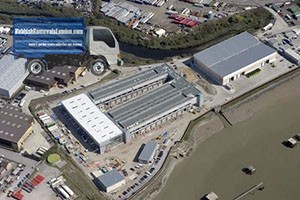The existence and use of waste incinerators is one of those highly debated issues which plague many large cities around the world, including the British Capital. Waste incinerators are basically massive furnaces which burnt junk and rubbish under controlled conditions.
The first problem with incinerators is that they do indeed reduce waste in size and volume, but they don’t necessarily reduce pollution that much since burning waste creates fumes and vapours. Although these are filtered and degraded as much as possible, a certain amount of pollution is expelled in the atmosphere.
One the other hand, waste incinerators are a much better alternative to landfills. Landfills will eventually poison the earth and its water resources, not matter how clever they are constructed, or how well situated geographically. Plus, landfills do not reduce waste in volume, they just hide it from view. Another benefit of incinerators which must be noted is the fact that they do create heat and energy for homes and businesses – again, not the best option to generate such resources, but better than plainly burning fossil fuels.
At the moment there are many active junk and rubbish incinerators around London. There are also some which are still pending completion or still in the process of applying for planning permission from authorities. It is natural for local communities and conservation groups to oppose construction and use of junk and rubbish incinerators but so far there has been no viable alternative proposed.
 In East London, there is the Frog Island Incinerator also known as East London Sustainable Energy Facility. The plant has hundred and thirty thousand ton capacity. This particular facility is a pyrolysis/gasification type incinerator intended to burn solid recovered fuels collected from municipalities. The gasification plant of the incinerator is permitted to burn SRF from municipal waste.
In East London, there is the Frog Island Incinerator also known as East London Sustainable Energy Facility. The plant has hundred and thirty thousand ton capacity. This particular facility is a pyrolysis/gasification type incinerator intended to burn solid recovered fuels collected from municipalities. The gasification plant of the incinerator is permitted to burn SRF from municipal waste.
Also in East London, though still pending construction is Green Sky London. When finished this waste incinerator will have five hundred thousand tons of processing capacity. This is a gasification class facility intended to produce jet fuels for BA from junk and rubbish collected in London. At the moment, there is no site selected, although the construction for the project was due to begin in the current twenty fifteen.
Thames Gateway Energy Facility, again in East London is a gasification type incinerator with a waste processing capacity of hundred and twenty thousand tons. It is intended to treat C&I (commercial and industrial) waste. The project was given planning permission by authorities in twenty eleven, apparently construction has commenced in twenty twelve.
Currently in North London there is the Edmonton Solid Waste Incinerator in operation. It is proposed for a new facility called Edmonton EcoPark to replace the existing incinerator by the year two thousand twenty five. The new facility is supposed to have seven hundred thousand ton waste processing capacity. However the project is still in its consultation and discussion stage.
Also in North London, there are plans to construct a gasification type incinerator which is still simply referred to as Brent Cross or Barnet Incinerator. When finished it is supposed to have a hundred and thirty thousand ton waste processing capacity separated for both domestic and commercial rubbish. Planning permission for the facility was given in twenty fourteen.

